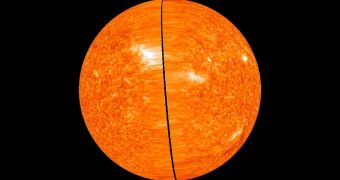Experts with the American space agency managed to obtain the first full view of the entire Sun on Super Bowl Sunday, which is when the two spacecraft making up the STEREO observatory made their ways on opposite sides of star.
The Solar TErrestrial RElations Observatory mission features two identical spacecraft, STEREO A and B, one of which leads our planet in its orbit around the Sun, while the other trails behind.
Yesterday, February 6, the two satellites were on opposite sides of the Sun, so they could image what went on on both its near and far side at the same time. The observatory only missed a very narrow section of the Sun, where their cameras could not make out details.
This is visible as the black stripe going down the center of the Sun in the image attached to this article. Other than that, all the phenomena going on on the star's surface could be analyzed.
One of the reasons why this is so important is because solar physicists could now get a clearer picture of what's going on when Earth is subjected to harsh solar weather, brought on by phenomena taking place underneath the solar corona.
In the future, these data will be used to create better, more efficient spacecraft to explore the Sun. Conversely, this could also be used to inform decisions about a prospective manned mission through the solar system.
“The Sun is a truly complex object which influences many aspects of our lives,” explains the principal investigator of STEREO's UK instruments, Richard Harrison, as quoted by Space.
“In the same way that you would not expect to understand the workings of the brain by studying just a small part of it, a global investigation into the nature of our star as a complete object is essential to understanding how it works,” he goes on to say.
The expert also holds an appointment with NASA, where he is a co-investigator of the Solar Dynamics Observatory (SDO) mission. That spacecraft analyzes the Sun's variability in extreme ultraviolet wavelengths (EUV).
“Solar missions such as STEREO and SDO not only give us more information about star formation and evolution throughout our Universe, but are of vital importance in our quest to further understand the Sun's processes and the effect they can have on our planet and way of life,” explains David Parker.
“This spectacular 360-degree view is another triumph for the STEREO mission, which continues to obtain some of the best images yet of the Sun,” he adds. Parker is the director of space science and exploration for the UK Space Agency.

 14 DAY TRIAL //
14 DAY TRIAL //